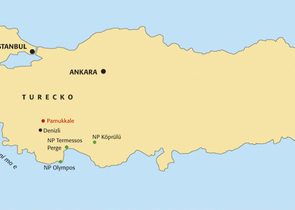Nature Conservation 5/2010 — 27. 10. 2010 — International Nature Conservation — Print article in pdf
Pamukkale – the good end of one story?

Pamukkale, meaning „Cotton Castle“ in Turkish, is a famous natural site in the Denizli Province in south-western Turkey, being one of the most magnificent natural monument worldwide.
The gleaming-white calcium formation (travertine pools) was formed when warm mineral water cascaded over the cliff edge, cooling and depositing its calcium. The calcium formed shelves, pools and stalactites. People have bathed in its pools for thousands of years to take advantage of the waters curative powers. Since the mid-20th century, many hotels and other facilities for particularly foreign tourists were built over the ruins of the adjacent ancient Greek city of Hierapolis. The tourist boom of the 1980s and 1990s had a detrimental effect on the site. A line of hotels above the travertines drained away the water. Since 1988, Pamukkale has been recognized by the UNESCO as a World Heritage Site together with Hierapolis. Since 1993, there have been efforts to restore the well-known site. The hotels have been demolished and visitors can no longer bathe in the travertine pools. Pamukkale is an example how human interventions which are not environmentally friendly can damage a unique natural phenomenon which hardly can be recovered to the original state, although expensive restoration measures have been implemented there.

